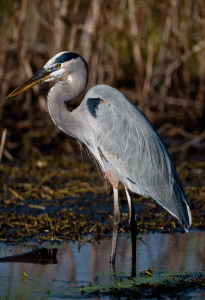
Great Blue Heron -Photo by Mike Williams
One of the most well-known is of course down feathers. Birds can grow or shed the down depending on ambient temperatures. Their insulation often involves growing an extra set of insulating downy feathers. Birds will puff up their feathers and turn into little fluff balls to help maintain body heat. Down jackets, vests, and sleeping bags have been used by humans for outdoor activities for decades. There are historic records of bird down being traded in the 1600’s. We know this is a good strategy to keep warm.
As in humans and other mammals, shivering generates warmth. Species like chickadees are experts in shivering. This isn’t the familiar tremble that mammals use to generate heat. Birds shiver by activating opposing muscle groups, creating muscle contractions without all of the jiggling typical when humans shiver. This form of shaking is better at retaining the bird’s heat.
We are all familiar with birds putting on fat for migration. They can also put on fat as both an insulator and energy source in winter. More than 10 percent of winter body weight may be fat in certain species, including chickadees and finches. As a result, some birds spend the vast majority of their daylight hours seeking fatty food sources, making feeder food even more precious for surviving a frosty night.
When I see a Great Blue Heron standing in ice cold water with its feathers looking like they are going to be blown off its head, I can’t help but wonder why it is not freezing to death. The reason is the blood vessels in the legs of birds are located right next to each other. Because of this, the warm blood flowing from the birds’ body transfers some of its heat to the cool blood returning from its feet via conductance. This helps the bird stay alive. If the warm blood didn’t heat the cold blood, the birds’ core temperature could be overwhelmed by cold blood from the feet. The bird’s core temperature would drop, endangering the bird. Blood flow is carefully regulated to maintain the delicate balance of providing oxygen and nutrient rich blood while maintaining core body temperature. While the core temperature of a duck or gull standing on ice may be 104 degrees F, its feet may be only slightly above freezing.
A bird on an icy sidewalk doesn’t feel cold from its feet the way you would if you walked barefoot over the same surface. Often, a bird will constrict the blood vessels in its feet to prevent additional blood from flowing into its toes.
Some birds save energy by allowing their internal thermostat to drop. Hummingbirds are a famous example of this, undergoing torpor nightly as their body temperature drops close to outside temperatures. But torpor is not too common in winter birds, because the morning warm up would take too much extra energy. Instead, kinglets and chickadees undergo a more moderate version of this, reducing their body temperature as much as 22 degrees Fahrenheit from their daytime level in a process called regulated hypothermia.
You’ll never find a warmer spot to sleep than in your own down feathers, nestled in a nook small enough that you can warm it up with any extra heat that does escape. Old woodpecker cavities, crannies beneath the eaves of houses, even a tunnel in the snow… they’re all warmer than spending the night (literally) out on a limb.
With all these strategies and adaptations, I can now better understand why birds don’t seem to be bothered as I am by the cold.
